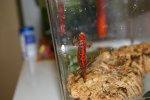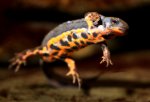The sex is quite difficult to determine from your photos, although based on the belly pattern (vertical striping pre-white dot development) and lack of prominent paratoid glands I would edge towards it being a sub-adult female. Males also develop a kind of curtain edge of bobbled skin around the flanks of the belly which I don't see here. There is however something distinctly male looking about the rear legs and vent region. Perhaps a close up shot of the cloaca would be more conclusive.
See the attached Sasayama newts, the two males on the left have very prominent glands on the head and rough edging to the belly. The female on the far right has small paratoid glands, which don't even feature in the photo, and a smooth edge to her belly, giving a more rounded look. Males have large cloacae even out of season and the paratoid glands become obvious at a very early age.
The second image of a male swimming shows the bobbled orange edge along the belly flanks more clearly.











